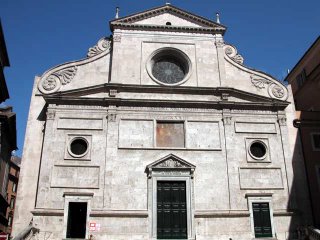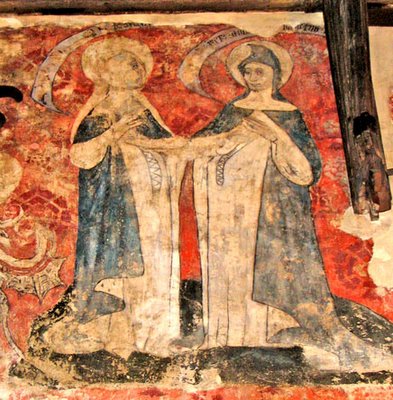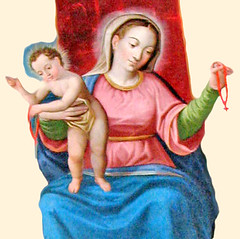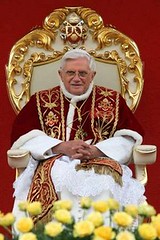To seek Mary's Contemplative Vision
 Station at Saint Augustine's
Station at Saint Augustine'sThe Station at Rome for today was at St Tryphon's, who died a martyr in the East. This church having been destroyed in 1736, the Station was removed under Pope Clement VIII to the neighbouring church of St Augustine. The church dates to the 13th-century and was entrusted to the Augustinians.
"Mary kept all these words and pondered them in her heart" (cf Lk 2:19, 51).
This Lent we too wish to ponder the Word of God in our hearts and contemplate the face of Jesus who "suffered and died for us" (Invitatory antiphon of Lent), so as to unite ourselves with Him through works of prayer, fasting and almsgiving. Of all the companions we could choose for this journey, none can compare with Our Blessed Mother. Thus, Pope Benedict XVI said of Our Lady, who is the Mother of the Church and Mother of all Christians: "Her whole programme of life [was this]: not setting herself at the centre, but leaving space for God, who is encountered both in prayer and in service of neighbour—only then does goodness enter the world" (Deus Caritas Est, 41).
Therefore, Mary's programme of life is rightly said to be ours too, for we, her wandering children, ought to look to her for maternal guidance and correction of life. For she whom "Of all mothers [is] sweetest, best" will surely teach us as only a mother can - with a mother's loving and gentle but firm hand. This Lent, as we embark on our Lenten observance, we can look to Mary for help and ask her to re-orient our lives so that we are more centred on her Son, Jesus Christ, our Lord and God.
Indeed, the goal of our Lenten journey is "to raise our minds to [God] and [to] grow in holiness" (cf Fourth Preface of Lent). Let us then consider the meaning of those words quoted above from St Luke's Gospel, words of Sacred Scripture that present Mary to us as the paradigm of the Christian disciple who "speaks and thinks with the Word of God" and whose "thoughts are attuned to the thoughts of God, [whose] will is one with the will of God" (Deus Caritas Est, 41):

"Why should this keeping and pondering be mentioned specifically...? Both are significant - the preservation, which makes her heart and memory into a treasure chest, and the pondering, which suggests something more present and dynamic, more life-giving, than a mere mental warehousing of words...
First the preservation - keeping things in herself... The words of God that [Mary] stores up in heart are at one with the Word of God that she brought into the world. After giving birth she has not stopped bearing the word within her. And yet she has brought forth from within her what she lastingly stored up - she has brought it forth as at once the Word of God and her word...
The other word, captured here with 'ponder', really means to collect, confront, encounter, compare. The term 'symbol' comes from the Greek word 'symballein', which refers to the sign of recognition between two guests - two pieces of the same object must be matched in order to make the symbol a mark of recognition, a point of connection, a form of evidence. In similar fashion the Latin word 'con-ferre' means 'bring together', draw together for comparison, bring into relationship. We find a singular passage in Paul (according to the Vulgate), where he says he compares the spiritual with the spiritual (spiritualibus spiritualia comparantes [1 Cor 2:13]). Many Church Fathers applied this to the dynamics of Christian contemplation and theology: a spiritual word of the Scripture is brought into relationship with another word, and behold, out of their mutual approach a new understanding dawns, a third word, as it were, that proceeds from the union of the two. If Christ himself calls himself the light and in another place calls himself the way, so arises the thought that we need his light to walk the way he is. The Bible is a totality, and no single word dare be expounded by itself without comparison to others. Christian contemplation thus opens itself to an unlimited field of activity; God's words reflect as in a hall of mirrors in which meanings multiply into infinity.
Mary wants to hold in her heart and rock back and forth precisely the ungrasped, uncomprehended word of the twelve-year-old [Jesus]. She lives in faith whose very essense is expansive, a seeking faith that finds much without ever concluding its perusal. With God a final vision is never possible; even in eternity we will not see exhaustively, for all discovery only provokes renewed seeking. 'Ut inventus quaerentur immensus est', Augustine said - God is 'beyond measure so that even when discovered he may be further sought'. So that we may eternally investigate the depths of deity, the Spirit of God who 'searches the depths' will be placed in our hearts (1 Cor 2:10, 12). Yet becaise this Spirit is already placed in our hearts (Rom 5:5), together with Mary as our model, we can begin the research securely believing, though not understanding everything, that God always opens himself up, even on earth, to the one who contemplates.
The Rosary is a prayer that both preserves and actively ponders, a prayer in which we, asking Mary for her vision, can penetrate the inexhaustible mysteries of the self-revealing God."
May St Augustine of Hippo pray for us and accompany us on our Lenten journey.
The image above shows Our Lady with St Elizabeth; both are very obviously pregnant and Our Lady, of course, bears the Word in her womb. This delightful wall painting dates to the 15th-century and is found in St Mary and All Saints church in Willingham, near Cambridge. Pre-Reformation wall paintings like this are very rarely uncovered as so many were destroyed and white-washed in the 16th-century.







0 Comments:
Post a Comment
<< Home